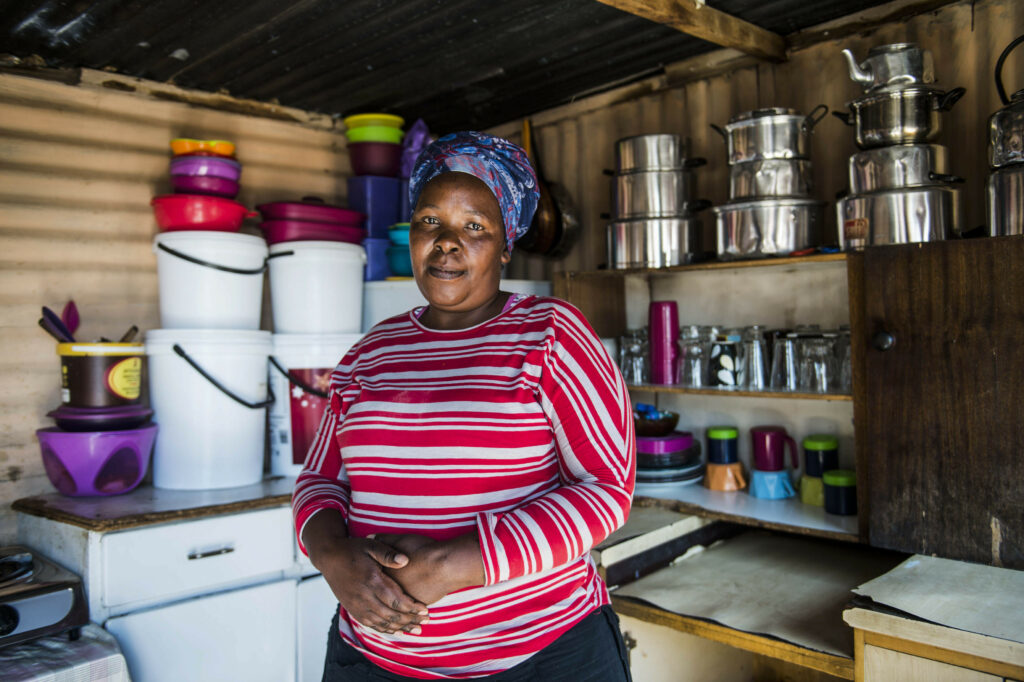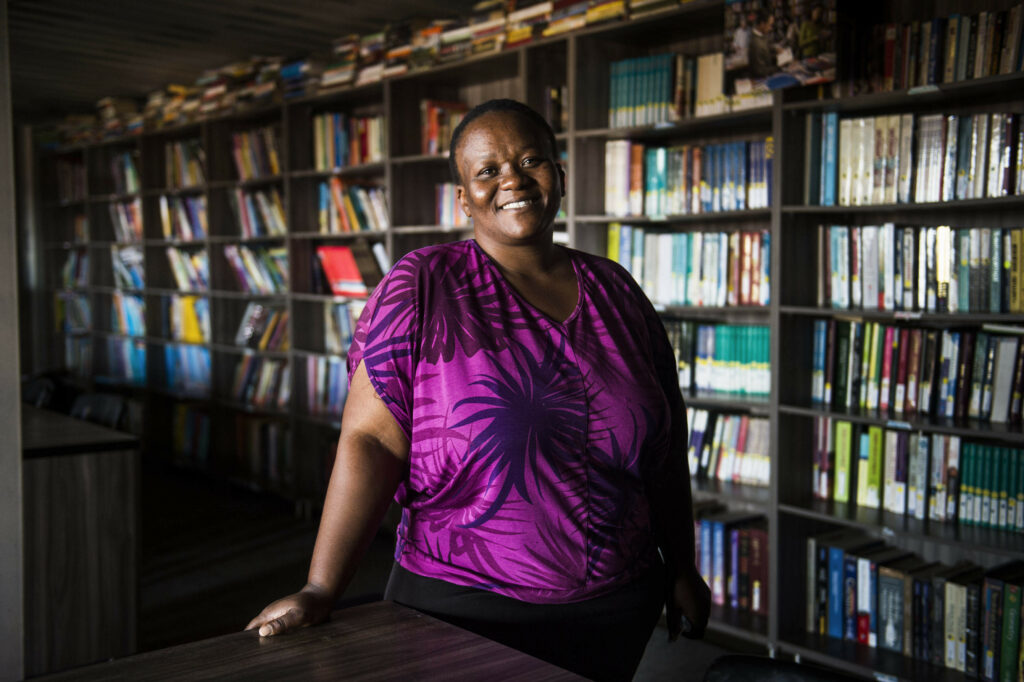Ongoing cycle: If a child grows up stunted due to malnutrition, it is likely
that her children will also be stunted. (Delwyn Verasamy/M&G)
Just last month, the cost of maintaining a basic nutritious diet for a family of four was R2 778.48.
This is according to the Household Affordability Index, which also shows that the average cost of feeding a child a basic nutritious diet per month was R710.75. But South Africa’s child support grant only covered 63% of this.
The child support grant has also been found to be 25% below the poverty line, and for a mother of three who lives at Vusimuzi informal settlement in Tembisa, east of Johannesburg, feeding her family with more than R2 700 seems like a luxurious concept.
Ncebakazi Ngozana originally hails from Mthatha in the Eastern Cape, and like many seeking a better life she came to Gauteng to look for a job. She lives with her three children and her 21-year-old brother.
To feed her family of five, she relies on the child grant and volunteering at a nonprofit organisation.
The child grant will be increased from R450 to R460 for each child in April. Ngozana told the Mail & Guardian that the extra R10 would make a difference in her household. This is despite experts calling the increase insufficient; they are advocating for one that will enable a basic nutritious diet for a child.
The R10 increase has been labelled as “worrying”, as the grant already did not meet children’s required nutritional intake. More worrying was that, unlike in other years, Finance Minister, Tito Mboweni, did not announce that recipients would get a top-up in October.
Katharine Hall, a senior researcher at the Children’s Institute, said that the grant remained the most efficient way to reduce poverty, with evidence showing that these grants were well used by recipients.
“The government cannot afford not to increase social grants. To allow the persistence of extreme poverty and child malnutrition is to ensure slow economic development — as we have seen for the past 25 years. Yet this is precisely what has been done again, even after the economic impacts of lockdown. The social grant increases that will come into effect in April are behind inflation. Effectively, the poorest people will be even poorer.”
However, Ngozana appreciates the increase.
 Making ends meet: Ncebakazi Ngozana has to feed a family of five on
a shoestring budget of child grants. (Delwyn Verasamy/M&G)
Making ends meet: Ncebakazi Ngozana has to feed a family of five on
a shoestring budget of child grants. (Delwyn Verasamy/M&G)
“I welcome the R10 increase because I didn’t have it before, so it will assist here and there.”
The R1 350 in child support grants Ngozana receives every month is spent on:
12.5kg of maize meal;
10kg flour;
10kg of rice;
Samp;
2-litre cooking oil;
2kg sugar;
Canned food;
Teabags;
Some chicken bones, chicken feet, chicken gizzards and chicken intestines from the local hawker;
R170 for gas, which she uses to cook with; and
R250 on burial society premiums.
Ngozana spends most of the grant money on prioritised food items, which have in the past six months increased by 5.6%, or R114.93.
She tries to focus on essential food items that are zero-rated (VAT free), but even that has not made any difference to how far she can stretch the grant, because even these have increased by 5% or R95.39, in the past six months.
The food items bought for the Ngozana household do not include nutritionally-rich foods such as eggs, meat and dairy, which have critical nutrients such as protein, calcium and iron.
There are few vitamin-, mineral- and fibre-rich foods such as vegetables and fruit; or foods with good fats such as maas, peanut butter and pilchards, which are all essential for her growing children, aged 14, seven and four.
According to the index, all these core foods that make up 54.5% of the average food basket have become quite expensive, at an average cost of R2 180.64 in February.
Fortunately, Ngozana gets some relief from her voluntary work. She and other women from her community have found ways to supplement their income.
The women receive vegetables, fruit, and care products — including sanitary pads, deodorant, toothpaste, soap and lotion, donated to the centre she volunteers at by various organisations.
“Since the grant gets finished before I can buy most of the things that we need, the donated food and cosmetic products help a lot.”
The Child Gauge has since 2015 been reporting on and monitoring the situation of children in South Africa.
The most prominent theme in the 2020 gauge was the nutritional status of children, which has been deteriorating at an alarming rate, leading to the report’s authors describing this as “the slow violence of malnutrition”.
According to the report, one in four South African children under five is stunted. This chronic sign of undernutrition has remained unchanged for 20 years. Over the same period, the country has seen a steady increase in childhood obesity, with a rate double that of the global average, affecting one in eight children under five years.
The Gauge also found that children from poor households are three times more likely to be stunted than children from the country’s wealthiest households.
With 30% of children living below the food poverty line of R571 per month, the report stated that it is not surprising that in children under five years, severe acute malnutrition is one of three leading causes of child deaths in South Africa.
According to Dr Chantell Witten from the University of the Free State, one of the co-authors of the report, its title was chosen due to the devastating consequences that South African children will carry into adulthood and through generations.
“It is slow, not only because of malnutrition but also stunting and obesity develops over time, and is more pronounced in children aged one to three years. In the case of stunting, the consequences of malnutrition are long-term consequences that impact not only cognitive development but also future earning capacity. [It is]violence because it is a violation of children’s rights, and violence because there are perpetrators.”
Dr Kopano Matlwa-Mabaso, executive director at the Grow Great Campaign — which aims to have the country reach a zero stunting rate by 2030 — said that South African children’s nutritional status was very bleak. She added that Covid-19 is “making an already bad situation worse”.
The country cannot afford to give up on ensuring that children’s nutritional needs are met, despite this bleak picture, said Matlwa-Mabaso.
“We cannot afford not to try. Stunting has detrimental long-term consequences for children’s health, education and economic prospects across the life course. This largely preventable condition robs children of living full and productive lives and traps them in intergenerational cycles of poverty, because stunted mothers are more likely to have stunted children.”
 Vital role: Patience Ramashapa is the operations manager at Tshepang
Care Centre. ECD centres help to provide nutrition for toddlers. (Delwyn Verasamy/M&G)
Vital role: Patience Ramashapa is the operations manager at Tshepang
Care Centre. ECD centres help to provide nutrition for toddlers. (Delwyn Verasamy/M&G)
This bleak picture of poor child nutrition conditions has been the lived reality for Patience Ramashapa since she started working as the operations manager at Tshepang Care Centre, a nonprofit organisation that supports orphaned and vulnerable children, near Tembisa.
Initially formed to cater to children from low-income families and those from child-headed households, the centre now feeds up to 500 people, including the elderly and youth.
But, said Ramashapa, more needs were identified as the centre grew within the impoverished community of Vusimuzi.
“We realised that most of the parents were unable to enrol their children at early childhood development (ECD) centres and this did not only affect the children’s readiness for school, but they were also not getting enough food, since the parents either relied on the child grant or they were undocumented migrants. That’s why we also opened the Tshepang Angels Day Care and Pre-School.”
Though Ramashapa has battled to feed the children nutritious food, ECD centres have been hailed for their role in ensuring that there is ongoing nutritional support for 69% of children between the ages of three and five.
While registered centres qualify for a subsidy of R15 per child a day, Tshepang Angels is one of the many centres serving the most impoverished communities excluded from the subsidy, because they cannot meet the registration requirements.
According to Ramashapa: “We don’t get any funding, so we feed them food from the donations that we receive that are meant for the centre.”
But such centres are vital, especially in communities where unemployment is rife, and where Covid-19 and the lockdowns have ravaged many households.
Baby foods are still loaded with sugar
The rising rate in the consumption of food high in salt, fats and sugar — but low in nutrients — is one of the drivers behind the increase in the obesity rate, the Child Gauge 2020 report has found.
With 13% of children under the age of five being overweight or obese, they are now at an increased risk of developing a chronic illness such as diabetes and heart disease.
In 2019, researchers from the University of the Witwatersrand analysed the sugar content in most commercially available baby foods such as cereal and processed purees, targeted at children under one year old.
The study’s findings showed that cereals had added sugar, while pureed and fruit desserts meant children had increased sugar levels equivalent to four teaspoons of sugar, or 20 grammes or more per serving.
These high sugar contents are behind calls for stricter control measures on the food industry to ensure that the food system adopts an approach that puts children at the centre, as called for in the report.
Dr Scott Drimie from the South African Food Lab said that political commitment would be needed in regulating the food environment, to make it easier for consumers to make more healthy food choices.
Without this commitment, enforcing the existing legislation such as the “sugar tax” would be a futile task if left to the food industry to self-regulate, Drimie argues.
“Creating an enabling environment for good nutrition demands far more than just recognising this influence and moving towards action. Senior officials at the national level do recognise this, but acknowledge how difficult it can be in practice.
“Without commitment and direction from the highest level in the state, enforcing regulation is often left to self-regulation, or at best threats of action and more stringent regulations in the future.”
Drimie also highlighted the current uncoordinated approach between the national and local governments, where local businesses such as spaza shops are often unregulated.
The 2013 Food and Nutrition Security Policy aims to ensure the availability, accessibility and affordability of safe, nutritious food at national and household levels.
According to Thulani Masilela from the department of planning, monitoring and evaluation, the plan is set to be reviewed in parliament to ensure that it meets children’s current nutritional needs.